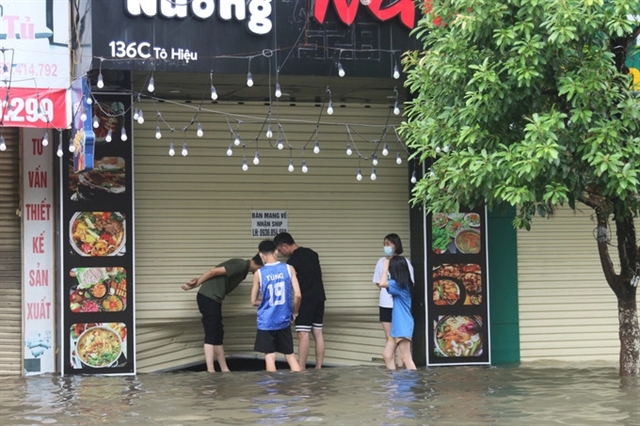 Environment
Environment


|
| Regular floods have caused damage and chaos for people in Hải Phòng. Photo nongnghiep.vn |
HÀ NỘI — Flooding has become a pressing problem in the city of Hải Phòng as it is getting worse and causing chaos for people’s lives, even when there is a small amount of rainfall.
This requires urgent and comprehensive measures to improve the capacity of water drainage in the city, according to Phạm Quang Quỳnh, chairman of Hải Phòng Water Supply and Sewerage One Member Limited Company.
In low-lying areas near Bính wharf, Lạc Long Bridge or Hạ Lý, Gia Viên and Tam Bạc wards, a small amount of rain causes serious flooding between 6pm to 9pm, greatly affecting people's lives.
Prolonged rainfall can submerge a large area of An Đà, Đổng Quốc Bình, Hàng Kênh streets as much as one metre under water.
Nguyễn Thị Trang, a resident in Tô Hiệu Street, told Hà Nội Mới (New Hà Nội) online newspaper that Tô Hiệu Street was severely submerged whenever it rained, but she still had to ride her motorbike along the street to get to her office.

|
| The rolling door of a restaurant at Tô Hiệu Street has been damaged by floods. Photo nongnghiep.vn |
The rapid urbanisation rate of Hải Phòng and the reduction of the number of ponds, lakes and canals are blamed for the situation.
The low road surface, unsynchronized drainage infrastructure system, and low awareness of the community to protect the drainage system also worsen the inundation.
Due to the impact of climate change and rising sea levels, Hải Phòng often sees heavy rainfall with high intensity between 100-250 mm.
Meanwhile, the total area of the regulating reservoir in the inner city is only 70 hectares, meeting 20 per cent of the surface water drainage area and restricting the storage capacity of rainwater.
Flood discharge at the hydroelectric power plant increases the water level by 50cm, followed by an increase of the tide to 4.4m, surpassing all the heights of the main road surfaces in the Tam Bạc and Cấm river areas.
Reports by Hải Phòng Water Supply and Sewerage One Member Limited Company showed that the current height of the inner city’s roads is only between 3.8-4 metres.
In addition, some wastewater drainage projects are unfinished.
But the tide in the city’s rivers reaches up to 3.9 metres. Heavy rainfall combined with rising sea levels has led to flooding.
According to Quỳnh of the water supply and drainage company the city's drainage system remains unsynchronized and is used for both wastewater and rainwater drainage.
Most of the lakes have an average depth of 2.0-3.5 metres, and the volume for rainwater storage accounts for about half of a lake's capacity.
Meanwhile, the reservoirs do not have a large capacity pumping station for water drainage.
Although the city’s old drainage system has been expanded and upgraded, the basic drainage system is still not synchronous, and new construction works are mainly built to solve the immediate flooding problem.
Currently, the city’s drainage system is divided into seven main basins, including 12 reservoirs with a total area of 67.97 hectares; 27km of canals; eight rainwater pumping stations; 22 tidal sluice gates; 652km of sewers, and a wastewater treatment plant and a sludge treatment plant.
The capacity of rainwater drainage is still limited and has to manage an average rainfall of about 50mm.
“With unusual weather caused by climate change and the current situation of the drainage system, flooding during heavy rainfall and high tides in Hải Phòng will worsen and occur more regularly,” said Quỳnh.
Measures needed
To solve flooding in the city, Quỳnh said in the coming time it would be necessary to build more than 447 kilometres of sewers and 33 rainwater pumping stations, which have been approved in the city’s wastewater and rainwater drainage planning.
It was necessary to review and adjust urban planning in the direction of increasing the level of natural adaptation to gain sustainable drainage as well as building drainage systems in low-lying areas.
Construction works needed to be elevated and set up a system of underground tanks and rainwater reservoirs to collect water on site.
In parallel, it was necessary to install additional pumping stations at the reservoirs, increase the capacity of the pumping stations to increase water storage capacity.
Encroachment or illegal construction works along riverbeds and drainage works must be strictly punished, he added. — VNS

.jpg)


